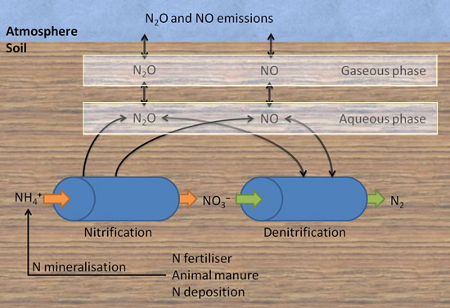Information For Growers
Greenhouse gas emissions and farming practises
Nitrous oxide (N2O) gas is emitted naturally from the microbial processes of nitrification and denitrification in the soil. The use of nitrogenous fertilisers, and the return of animal dung and urine, in agricultural activities increases the soil content in mineral nitrogen. In turn, this increases the rate at which bacteria release N2O. The figure below summarises the soil nitrogen cycle.

Along with carbon dioxide and methane, N2O is a powerful greenhouse gas (GHG). Increased worldwide GHG emissions due to human activity can intensify the greenhouse effect which leads to climate change. In Australia, agriculture is the dominant human source of the greenhouse gases N2O and methane1. The table below shows the main on-farm sources of GHGs.
| Greenhouse gas | |||
|---|---|---|---|
| On-farm greenhouse gas emission sources | Nitrous oxide | Methane | Carbon dioxide |
| Fuel | ✓ | ||
| Cultivation | ✓ | ||
| Crop residue decomposition | ✓ | ✓ | |
| Nitrogen application | ✓ | ||
| Burning crop residues | ✓ | ✓ | |
| Biological nitrogen fixation | ✓ | ||
| Waterlogging | ✓ | ||
| Animal emissions | ✓ | ||
| Manure management | ✓ | ✓ | |
| Lime application | ✓ | ||
| Urea application | ✓ | ✓ | |
Increased N2O emissions have harmful long-term effects in the lower and upper atmosphere. Unusually high levels of N2O emissions also indicate fertiliser overuse and lead to ecological damage from the leaching of nitrates into groundwater or by entering the water systems of other ecological systems as runoff.
Reducing on-farm N2O emissions
Farmers can adopt a range of N2O management techniques to reduce emissions from agricultural soils. For example, by changing the timing, type and amount of nitrogenous fertiliser applied to the soil; using nitrification inhibitors and cover crops; adopting sustainable tillage systems; and improving irrigation practices and good manure and soil management. These management practices might be the basis for a future national strategy to reduce GHG emissions from agricultural soils.
N2O research can help by identifying optimal fertiliser application regimes; ones that will maximise yields whilst minimising emissions. By applying nitrogenous fertilisers more efficiently, farming can also become less resource-intensive and lower its costs through the reduced use of fertiliser. This also improves the ecological footprint of farming activities by reducing gas emissions and minimising the harmful effects of nitrogenous fertilisers.
N2O research and the N2O Network
Further research is still needed to determine how to best reduce N2O emissions. The complex interactions between all three major GHGs as well as the soil properties unique to each crop need to be taken into account when studying N2O emissions.
Emissions research has traditionally mainly focussed on carbon dioxide and research data on N2O soil emissions from Australian soils is still limited. The N2O Network is the first effort to bring together researchers who measure and model N2O emissions for dryland and irrigated farming (particularly grains, cotton, sugarcane and dairy) from sites around Australia.
The N2O Network will provide the latest available scientific knowledge on reducing N2O soil emissions in the form of tools and advice to farmers, consulting agronomists, extension officers and policy makers. The N2O Network will also help researchers standardise their datasets and collection methods to produce more powerful simulations of emissions for various land-use types and climatic conditions.
A central database of N2O research will be made available by the network to the wider GHG research community for further analysis and interpretation.
Fertcare
Understanding nitrous oxide emissions from agriculture and principles for mitigation
This document presents the current state of knowledge relating to the processes responsible for nitrous oxide production and emission from agricultural soils. That knowledge is then used to develop some general principles that should be considered in managing specific agricultural production systems. The aim has been to produce a technical resource for farmers and service providers, especially those in the fertiliser industry, who provide advice and guidance to farmer managers
1 Australia‘s National Greenhouse Gas Accounts, National Inventory Report 2007 Volume 1 (p. 21)
